German and Austrian Copper and Brass
(c) Antique Metalware Society
Small extracts can be used with acknowledgements to 'Oldcopper.org' website.
Helpful comments are very welcome.
This covers some of the makers and quality marks commonly found in Austria and Germany.
The Bauhaus was founded in 1919 in the city of Weimar by German architect Walter Gropius. Its core objective was to reimagine the material world to reflect the unity of all the arts. In 1925, the Bauhaus moved from Weimar to Dessau, where Gropius designed a new building to house the school. Ludwig Mies van der Rohe succeeded him in 1930 and had to relocate to Berlin where it had to close in 1933.
 |
|
DRGM German patent mark (meaning Deutsches Reich Geschmacksmuster (or Gebrauchmuster?)) that appears with or without a registration number. It seems to have been introduced around 1891 and was used on both domestic and industrial designs as well as jewellery. Officially it was withdrawn in 1945 but also appears on some items of a later date. This is a rare example of the use of both design registration marks, found under a good folding letter rack made from sheet brass. |
|
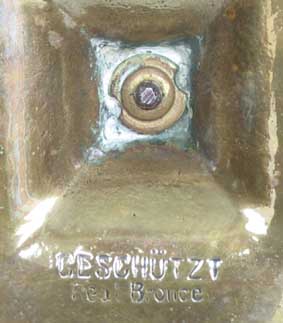 |
|
Geschützt, Geschutz, Geschuetz, German mark covering a proprietary copyright, used until 1883. (Geschützt = 'Protected' in English). The mark was also used in Austria. This one is on a candlestick base. Ges. Gesch. (gesetzlich geschützt) used in Austria and Germany to note copyright protected design. Musterschutz Another term for protection of registered designs used from late 19th to early 20th centuries. It is seen on both cast and wrought brassware but occurs most often under ceramic steins and some plaques. |
|
|
DIN Deutsches Institut für Normung e.V. is the German national organization for standardization. There are currently around thirty thousand DIN Standards, covering nearly every field of technology. List of DIN standards. DIN represents Germany's co-operation on European (CEN) and International (ISO) standards committees. |
|
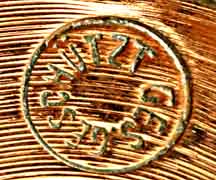 |
|
| Geschützt, in a circular stamp on a screw nutcracker. | |
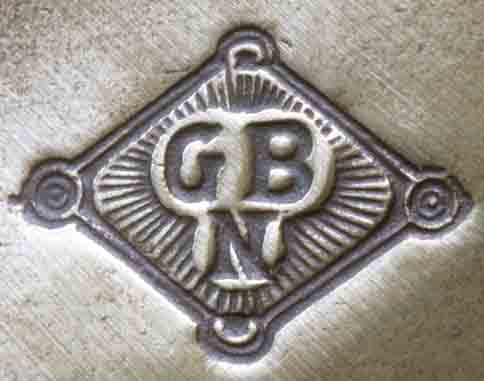 |
|
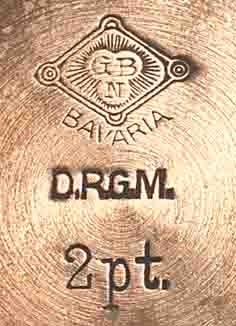 |
|
| Gebrüder Bing, Nürnburg, Germany, founded in 1863 byIgnatz and Adolf Bing, initially making kitchen items and later becoming one of the largest toy manufacturers in Europe. They closed in 1932. The copper factory site in Nürnburg was taken over by Diehl Metall in 1938. This mark is said to have been popular during the period 1906-1912. The lower one was found under a kettle calibrated to 'Two pints'. | |
 |
|
| Harald Buchrucker, (1897-1985) metalworker in Bauhaus style during the 1930s in Germany. | |
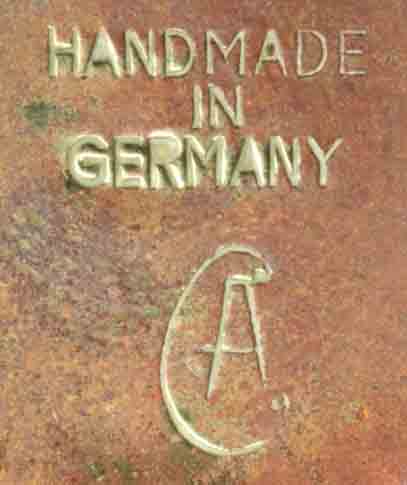 |
|
| 'CA' or 'AC' unknown monogram found under a well styled thin copper jug of mid 20th century. Further details welcome. | |
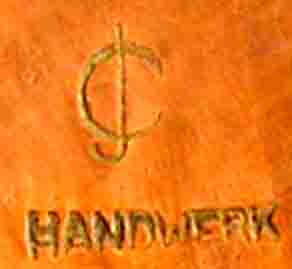 |
|
Unknown coppersmith mark. Possibly the mark of Joseph Bernard Citroen, a Dutch metalworker. (Thanks to Bob de Bouwer) |
|
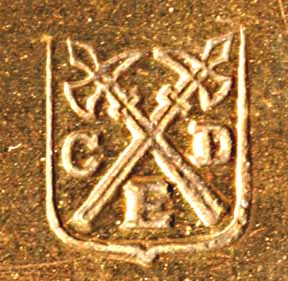 |
|
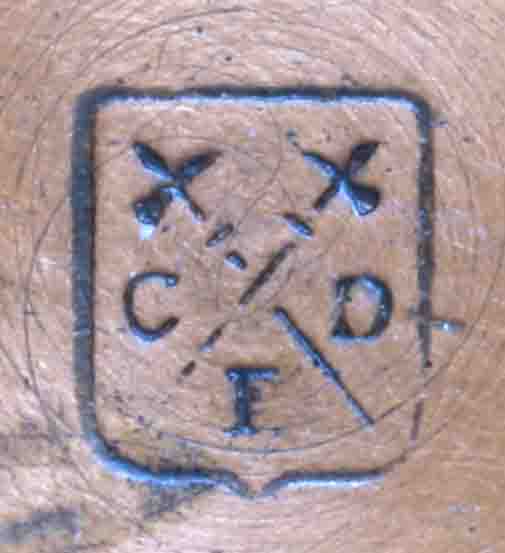 |
|
| Carl Deffner, Esslingen, Germany, decorative copper, brass and plated tableware. He was born in 1856 and took over management of his father's metalware factory in 1900. Responsible for many excellent designs during the art nouveau and art deco periods. The factory closed in 1959. | |
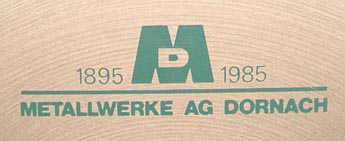 |
|
| Dornach, Switzerland. Marks D. | |
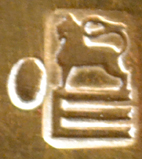 |
|
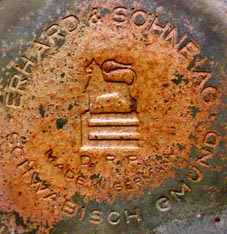 |
|
| Erhard & Söhne was founded in 1844 by Gottlieb Erhard and his two sons in Schwäbisch Gmünd, about 50km east of Stuttgart in Baden-Wutttemberg, Germany. During the company's life, they made a variety of products including haberdashery also silver plated or gold plated brass and bronze, dollshouse accessories and toys. Since 1945 the company has specialised in the Unimog range of 4-wheel drive utility vehicles. (ack: Wikipedia). New Text Page :- Erhard and Sons. | |
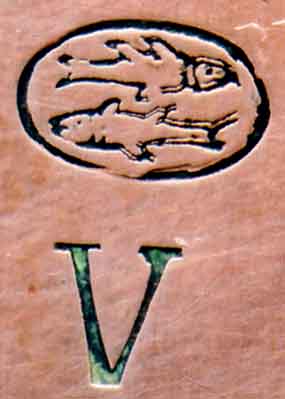 |
|
| F & R Fischer, Göppingen, between Stuttgart and Ulm in Baden-Württemberg, Germany. Göppingen is on the River Fils and just downstream of Geislingen, home of WMF. It was founded in 1874 by Fritz and Robert Fischer. Most of the firm closed during the financial crisis of 1934 but some products were still being made until 1966. They produced well designed art metal hollowware and dishes bearing the distinctive twin fish mark. This one under a spirit kettle. | |
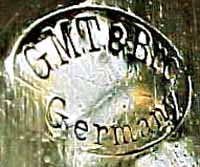 |
|
GMT & Brc., Germany, unknown mark on a brass tea caddy. More information welcome. |
|
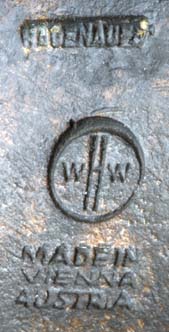 |
|
Franz Hagenauer mark, Vienna, Austria. Austrian designer Carl Hagenauer established Hagenauer Werkstatten in 1898 and produced decorative metal wares and bronzes designed in-house in the modernist and Jugendstil styles. (Several websites). |
|
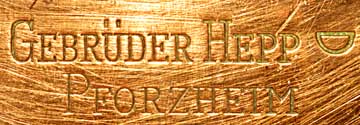 |
|
| Hepp Brothers, Pforzheim, Baden Württemberg, Germany, makers of copper cookware. | |
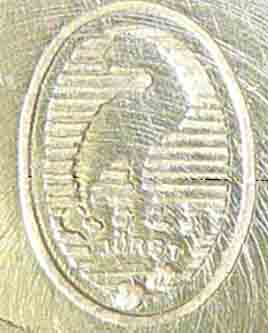 |
|
| Jurst mark in a crown under a long-legged bird under a brass spirit kettle. Berliner Metallwarenfabrik, H. A. Jurst & Co., founded 1847, became part of Fankonia Co in 1925 but continued for some years after that (Thanks to D Vladov & Bahner, Berlin) . (Photo: Marianna Beem) | |
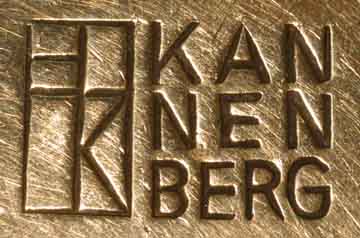 |
|
| Kannenberg, Germany, maker unknown, details welcome. This mark on a lidded pot copper, brass and pewter in the secessionist style of Wiener Werkstatte. | |
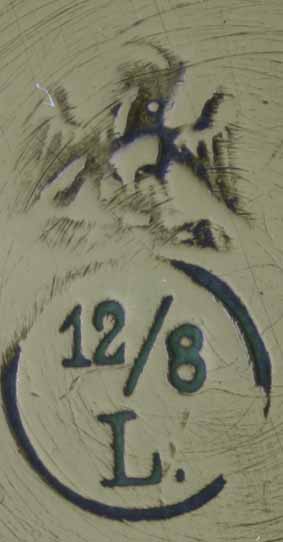 |
|
| J P Kayser & Son of Krefeld-Bochum, near Düsseldorf, Germany were originally 'Leuconide Metalware Factory, founded around 1885. They were tin manufacturers and developed a lead-free pewter with the trade name 'Kayserzinn' from 1894 to 1912. Under Jean and Engelbert Kayser, this was used in the making of Jugendstil items designed in Cologne by Hugo Leven and others. They also produced well-made copper and brass items and used the mark shown here, found under a 1.5 litre brass spirit kettle c1895. Other marks were used for the pewter items, numbered from 4,000 to 4999 during the period 1894-1925. | |
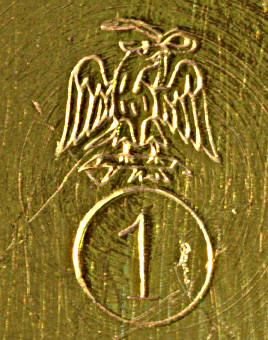 |
|
| This is a clearer example of the logo showing an eagle on a branch and looking right with a snake in the beak. It was found under a spirit kettle. | |
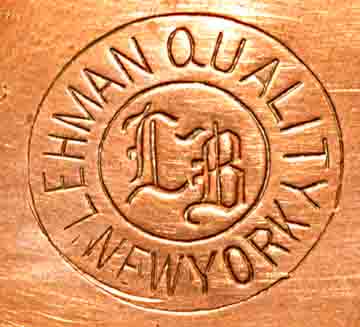 |
|
Lehman Brothers, Germany, copper and brass holloware. Their agents in Britain were possibly Adolp Frankenau & Co of 121, Queen Victoria Street, London EC. Lehman now make the LGB (Lehman Gross Bahn) range of garden railway models. This mark was used for items sold in the USA. |
|
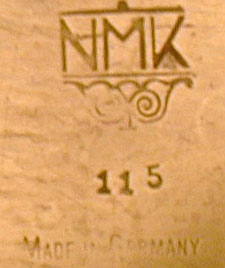 |
|
| NMK, Neues Münchner Kunstgewerbe, (New Munich Arts and Crafts) founded in 1919 by Alois Wörle, a gold and silversmith from Munich, Germany. (Thanks to Tom of www.925-1000.com). (Photo by Elizabeth Nevin). | |
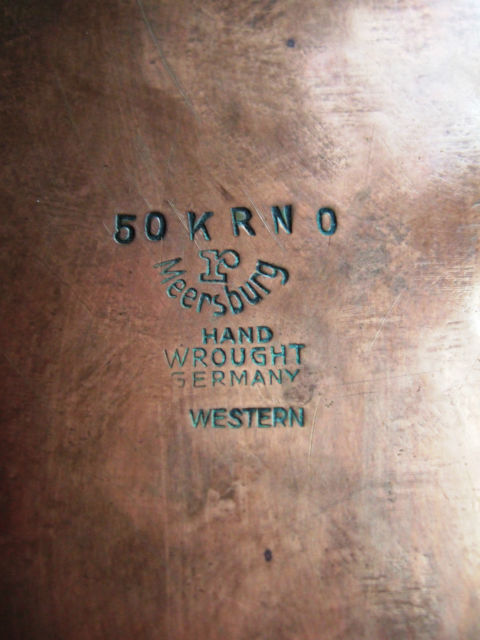 |
|
| Meersburg 'r' mark. German Copper Cookware by Karl Raichle (1889-1965). He studied at the Bauhaus, Weimar in the 1920s before starting the Forge Karl Raichle in Meersburg, Bodensee, Baden-Württemberg, in 1930s. | |
 |
|
| MIW These letters were for" Metall-Intarsia-Werke". 1886 saw the foundation of Luppe+Heilbronner OHG by Otto Luppe and Milton Douglas Heilbronner. The main products then were chemically etched brass smoking accessories such as ash trays, smoking tables ,cigar boxes, but also etched brass inlays for furniture decoration. This mark is from the base of a brass inlaid humidor. (Thanks to Guido Smoglian). | |
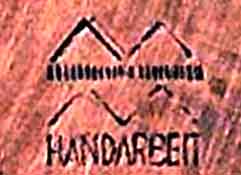 |
|
| MM Handarbeit mark on hand made copperware. Mussbach Metall Gmbh & Co. KG, Neustadt an der Weinstrasze, Germany. (Thanks to Trent, the Ozark Antiquarian). | |
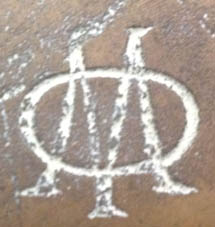 |
|
| 'MO' or 'OM' mark, unknown but found also with a German DRGM mark. More information welcome. | |
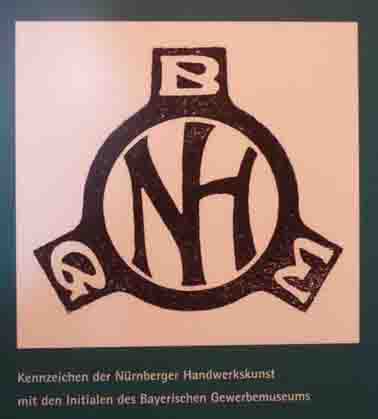 |
|
| Nürnberg Handwork Guild with the initials of the Bavarian museums. | |
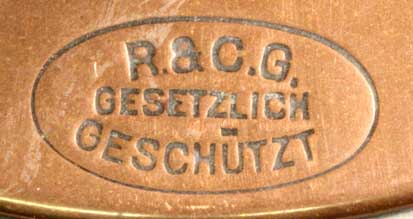 |
|
| R & C G maker's mark found on a copper coffee percolator. Identification of the maker welcome. | |
| 'Rhein Küpfer' German term for 'Pure copper'. | |
.jpg) |
|
| RICHARD ROHAC mark under a blackened brass ashtray. Rohac began and completed his apprenticeship with Werkstätte Hagenauer Wien in Vienna as a teenager, and stayed with the workshop another nine years before opening his own metalwork business in 1932. | |
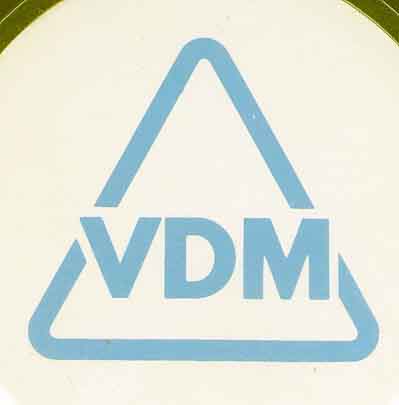 |
|
VDM Metals GmbH (Vereinigte Deutsche Metallwerke) Corrosion resistant copper alloys, nickel coppers and stainless steels. |
|
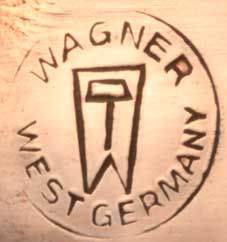 |
|
 w.jpg) |
|
Christian Wagner, West Germany. 'This German company was run by my father and forefathers from 1524(!) until 1995. The hammer inside the "W" is the traditional mark of the company. Starting from coppersmith craftsmen, in the 1900's the company was transformed to an industrial enterprise, based in Esslingen am Neckar near Stuttgart in South Germany. Besides the traditional copperware, the company was famous for professional kitchenware of unique quality. In the 1990's, when more and more cheap kitchenware from far east came onto the market, this company had to give up, as so many other traditional brands and companies. The picture shows Christian Wagner, who was coppersmith in the 19th century and gave the company its name.' (ack: Reinhard Wagner). |
|
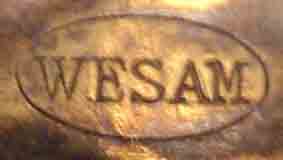 |
|
| Wesam unknown mark, more information welcome. | |
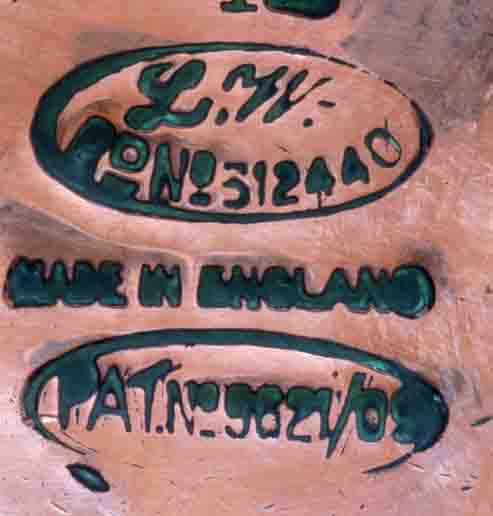 |
|
| L.W. mark of Louis Wiener, inventor of a patented coffee percolator with an 1898 design registration and patent number. This item was made by F & R Fischer although marked 'Made in England'. (Thanks to Alastair Lamont). | |
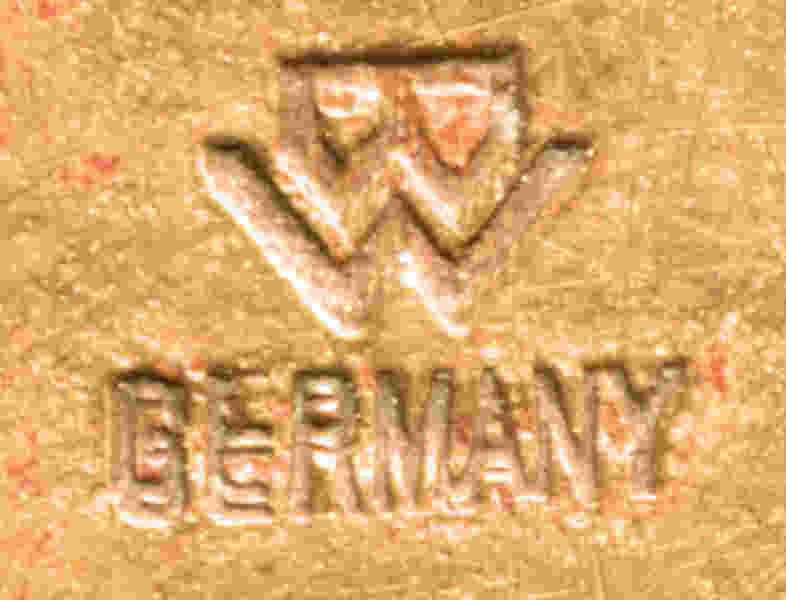 |
|
| Unknown mark under an art nouveau brass ash tray. | |
 |
|
| WMF (Würtemburgische Machin Fabrik AG), originally founded in 1853 in Geislingen an der Steige, Germany. See separate wmf page. | |
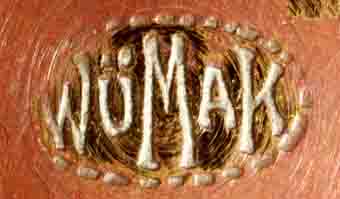 |
|
| Wümak Berlin. Würtemburgische Metallmanufaktur Adolf Knecht G.m.b.H, established 1899 in Cannstadt, Stuttgart, Germany. The firm has specialised in paper oil filters for the automotive industry since 1933. Mark found under a pair of brass vases. | |
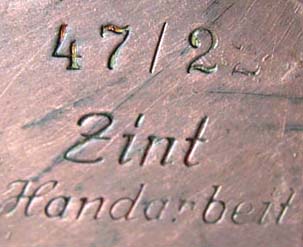 |
|
| Mark for Eugen Zint who had a copperworks at Riedlingen, Baden Württemberg, on the River Danube in South West Germany. He produced high quality pieces c1930 and had an association with Bauhaus design architecture. (Photo courtesy Barbara Turner, information from Ross Jackson and vendors). | |
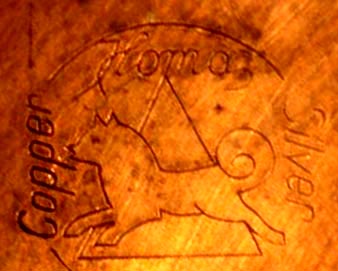 |
|
| Unknown mark, information welcome. | |
Copper Museum Pähl-Fischen a.Ammersee, not far from Munich, Germany. Below are some marks found on items on display. (Thanks to Karin & Ulrich Burchard).
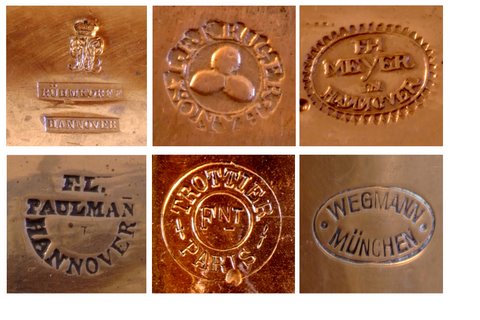
Home.
A